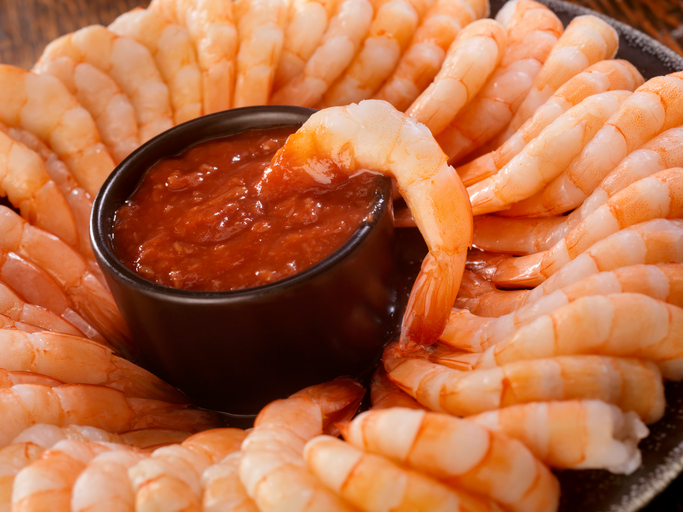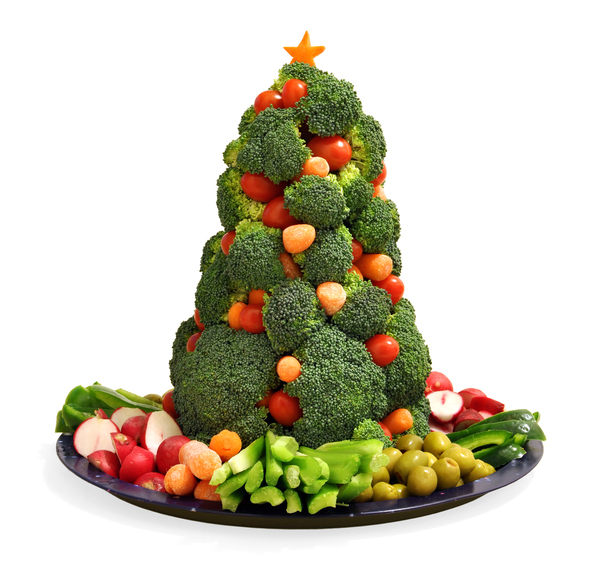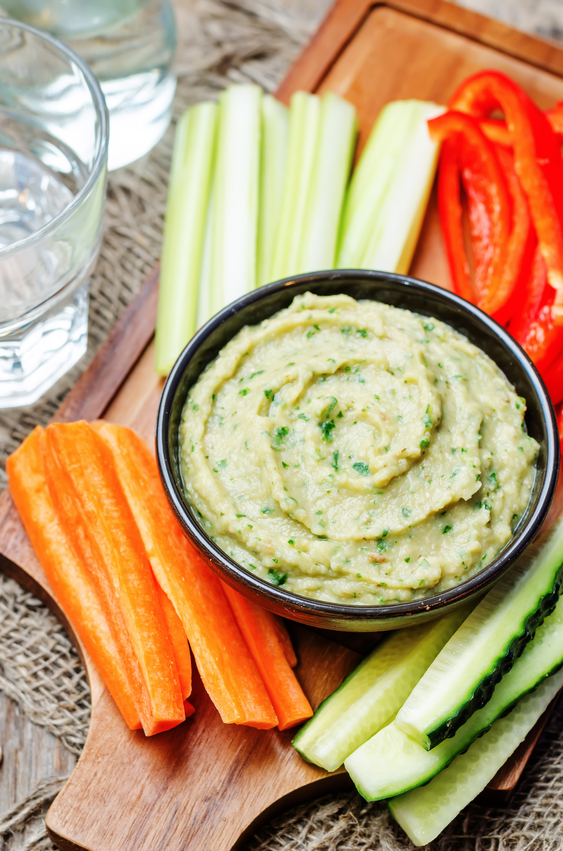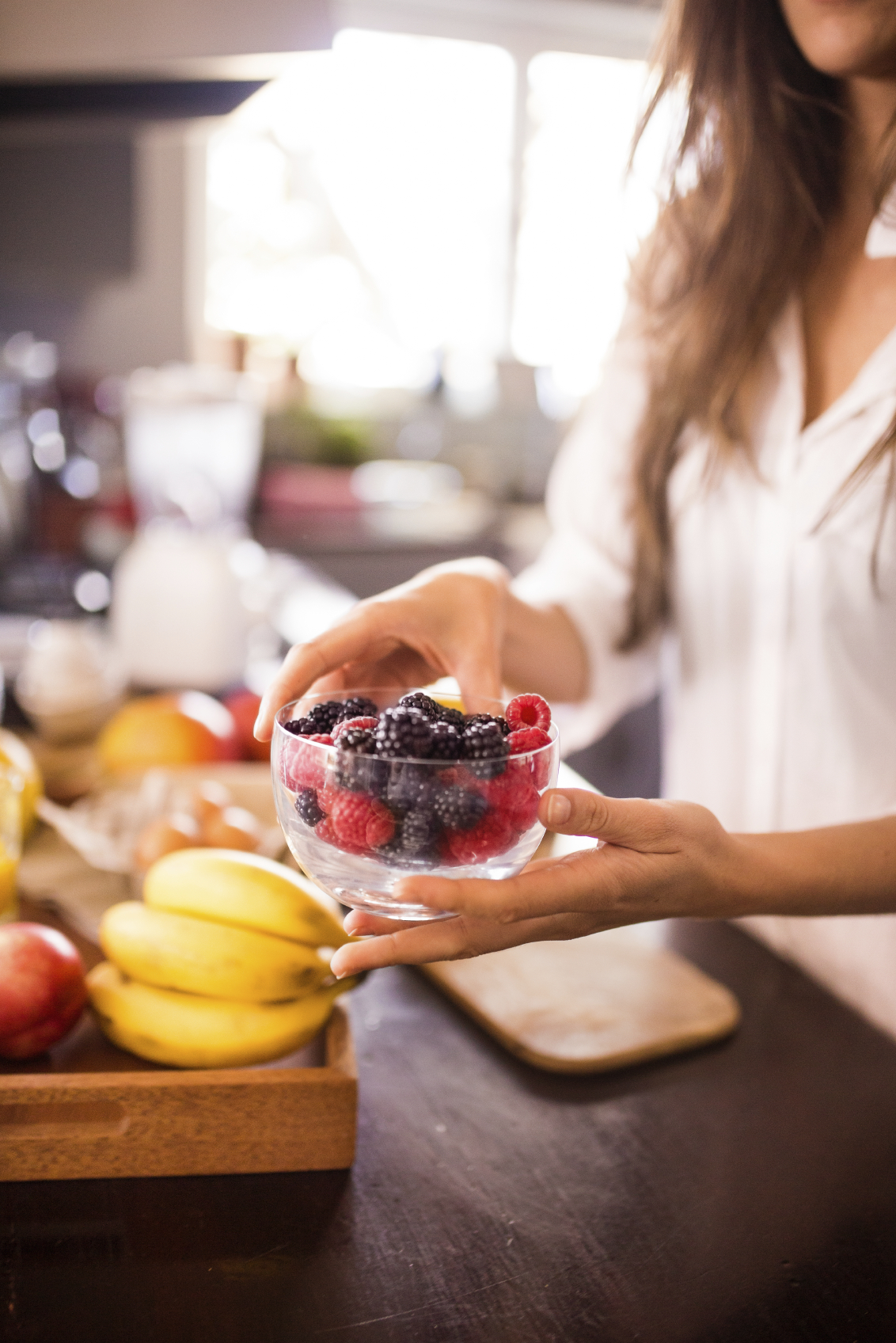Written by Maureen Murphy

Although it’s the season for holiday parties and special meals it’s also the season when many people find themselves gaining an extra 5-7 lbs. from overindulging in sweets, dips, and more. With a few simple tips and modifications your guests will still enjoy the party and their hips will thank you come January!
Simple tips & cooking modifications:
- Serve veggies, pretzels, or baked pita chips for dipping instead of potato chips
- Serve shrimp cocktail and a veggie tray for lighter snacks
- Use low fat or nonfat dairy products to replace higher fat counterparts
- Serve whole grains – breads, rolls, pasta, etc.
- Flavor roasts and vegetables with fresh herbs and a little grated Parmesan cheese instead of butter and/or salt
- Roast meats and poultry on a rack in a roasting pan
- Skip the gravy entirely or at least skim fat off (every tablespoon of fat discarded amounts to 120 calories and 13 grams of fat)
- Use fat free milk or reduced sodium chicken broth when making mashed potatoes, and add garlic and herbs to enhance the flavor

- Season vegetables with herbs, spices, balsamic vinegar and/or lemon juice instead of butter or heavy sauces
- Reduce sugar called for in a recipe by a third
- Substitute an equal amount of applesauce or prune puree for at least half the oil, margarine, or butter in baked good recipes
- Substitute a graham cracker crumb pie crust for the traditional pastry crust, and use half the butter or margarine called for in the crumb crust recipe, adding a little liquid to moisten if too dry
- Have water or diet soda available for guests to choose instead of higher calorie and sugar beverages like alcohol, soda or juice
- Skip dessert and serve fresh fruit for a light end to the meal
Ellie Wilson, MS, RDN, Senior Nutritionist
The American Heart Association, long known for their efforts to educate Americans about the best ways to enjoy great heart health, began a new tradition several years ago with National Eating Healthy Day. It always falls on the first Wednesday of November, and seeks to help people keep their heart in mind as the holidays begin.
The theme this year is “Be Colorful”, to get us thinking about and enjoying more fruits and vegetables at all of our eating occasions. You can add more produce to your diet with these easy, quick tips:

- Power up breakfast with some dried fruit in oatmeal, like dried cherries and apricots.
- Make that morning snack a small apple and a light cheese stick – produce plus protein is perfect!
- Add some extra frozen or canned veggies to your lunchtime soup, or mix bagged, chopped salads with romaine lettuce for a quick power salad. Dress with balsamic vinegar and a drizzle of olive oil to keep the taste high and calories low.
- Hummus and cut veggies make a flavorful, plant-protein and fiber-rich afternoon snack.
- Double up on dinner vegetables – double servings of the same item, or mix and match fresh/ready-to-eat vegetables with your favorite cooked ones – with produce, more is always better!
Get your holiday season started with National Eating Healthy Day and give your heart a great gift!
https://www.pricechopper.com/recipes/11374/Caramelized-Brussels-Sprouts-with-Lemon
https://www.pricechopper.com/recipes/7283/Apple-Date-Squares
http://www.heart.org/HEARTORG/HealthyLiving/HeathyEating/Nutrition/National-Eating-Healthy-Day_UCM_454414_Article.jsp#.WA-K9fkrKM8
 Written by Ellie Wilson, MS, RD Senior Nutritionist
Written by Ellie Wilson, MS, RD Senior Nutritionist
January is resolution season, with weight loss topping the chart for many people. January 17
th through the 23
rd is Healthy Weight Week, and Friday the 22
nd is Healthy Weight Day for women. In the spirit of keeping it fresh, here are some ideas for helping set and really reach your goals in a healthy way.
Visualize the Process, Not the Result
Research has shown that visualizing the end result can trick us into thinking we have already made a good effort, which then reduces execution of our plans. The better strategy is to keep visualizing what you are doing to reach your goal – planning a menu, making lunches each day, exercising – basically, visualizing the lifestyle actions that will get you to your goal, versus what you will look like at any stage. The doing is what brings the success.
Craving Crusher
A study released last year tested a method for distracting us from capitulating to cravings. Tapping your forehead, ear or toe for 30 seconds has been shown to successfully diminish cravings for even our most favorite items. The research was done at Mt. Sinai in New York City, and offers an easy and accessible tool for those plagued by visions of favorite foods when they are managing calories.
Get Lean with Protein
Including some protein with each meal has multiple benefits for weight loss – it helps to preserve muscle, and improves satisfaction with meals and snacks. Several studies have shown greater fat loss with higher protein-calorie controlled diets. Proteins include lean meats, seafood, beans, legumes, nuts and low fat dairy, so there is great variety to keep interest and appetite engaged.
Fiber Facts
Whole grains and higher fiber foods, containing both soluble and insoluble fiber, help us fill up without filling out. High fiber foods tend to be lower in calories, and are also good for digestion. Foods to choose include vegetables, fruits, legumes, nuts, seeds and whole grains.
Enjoy a great New Year and success with all of your health goals!
Written by Ellie Wilson, MS, RD Senior Nutritionist
Many people are on a budget these days and that tends to raise awareness of all kinds of things, including how much food we eat. For those managing diabetes, being aware of food and what its impact is on blood sugar is important, but more than once I have heard that eating healthfully is too expensive. Balancing the budget and balancing health is possible, with a few insights and a little planning.
Planning is the first hurdle – so many of us are so busy, we find it easy to ignore the concept. However, most of us plan “accidentally” – many people have a set routine for meals they cook throughout the week, as well as typical items they buy or prepare for lunch, dinner and snacks. It often changes seasonally – salads in summer, with meat on the grill; soup in the fall and winter, as well as crockpot meals. The first step to planning is just putting your “usual’s” down on paper, with dollar amounts you usually spend (or the budget amount you are trying to stick to!)
You don’t have to change everything to eat healthier on a budget, just tweak what you usually do. Do you buy rotisserie chicken for Monday nights, when you don’t want to cook? Plan on scooping out some frozen broccoli from a bag in the freezer, and microwaving a small potato – done, healthy, fast, and cheap. Both the frozen broccoli (as well as any other frozen vegetable or fruit) and the potato are very economical choices for eating well. Try a little herb seasoning, lemon or ginger in the cooking water of the broccoli.
Breakfast is also easy – eggs are a really inexpensive source of good protein, and easy to mix up with leftover vegetables for an omelet. Wheat bread is the new white bread – we now eat more wheat bread than white in the U.S., so it should be easy to find an economical choice that has at least 2 grams of fiber per slice.
Manage meat – check on the sales, slice thinly, store leftovers properly, and you can probably turn down the volume but

turn up the lean, more nutritious protein choices – trade up to seafood and lean meats. Coupons are also a tool in your toolbox – check out that list of usual’s every week, and connect coupons where you can – you’ll get the best nutrition as well as the best bargain!
Medication connection – check out the Price Chopper Diabetes AdvantEdge program. Multiple medications, insulin syringes, pen tips, lancets and lancing devices – are all free. That will definitely lower the cost of diabetes management! Here is a great
EatingWell® recipe that puts it all together – enjoy!
Written By: Ellie Wilson, MS, RD Senior Nutritionist, Price Chopper Supermarkets

I hear a lot from people these days about getting back to basics, cooking and eating at home more, and reconnecting to families. I love this trend, and hope it becomes the new normal, for the sake of some very important people, our children. I say that because a great number of children are struggling with poor nutrition, particularly being overfed and undernourished. We have some work to do.
Children learn almost all of their food skills and practices from their parents. They add those skills up the same as they add the ability to walk, talk, think, play and draw, with different skills gained at different stages of childhood. To help parents develop the food skills their children need, I am sharing some make-it-happen ideas, tested by USDA, to help our children grow strong and healthy. Here they are:
- Parents of preschoolers: eat well, and your children will too. They will eat the fruits and vegetables you eat. They can learn basic food preparation by helping you with safe food tasks, picking out some fruits or vegetables when you shop, and having you explain what you are doing as you cook and prepare food. Be persistent with new foods – it takes time and sometimes more than 12 tries with a new food before a child will accept it.
- Parents of elementary school-age children: make it easy for kids to reach for a healthy snack – keep fruits and veggies ready. Use carrots and cut up veggies for snacks after school, and count them as part of their dinner veggies! A great way to ensure kids are getting nutrition that helps them grow and keeps them strong is to have low-fat milk with meals. A nine-nutrient package, low fat milk is a powerhouse, a shortcut to better nutrition, and is an easy way to round out any meal.
- Parents of 8-10 year olds: these kids are growing fast, and are active. Support that activity by helping them snack well, with fruit and yogurt. They need to eat smart to play hard. They can assist with preparing fruits and vegetables, and the more they know how to do that, the more they will do it (so you don’t have to!). Super kids need superfoods!
Written By:
Ellie Wilson, MS, RD, CDN Senior Nutritionist, Price Chopper Supermarkets

New Years’ resolutions, top ten lists, favorite ways to be more healthful – January signals the start of “wellness season” for most of us, and the appearance of many stories and articles that will offer to assist us all take charge of our health. Not to be outdone, I hope you will find this one to be even more helpful, as my goal is to offer some very specific information you can use as you move through the store. Check out these aids and ideas to help you meet your own goals for better nutrition, feeling good and looking good.
A little reminder – Price Chopper was the first supermarket to install the NuVal ®Nutrition Scoring system in all of our stores, to help our guests easily compare foods and “trade up” to better choices. Choosing foods above the average for the food category can help you be sure you’re doing a great job for your health and for your family. Here are some best practices;
- Eat Breakfast – More and more research is showing the power of breakfast to assist with weight loss, improve energy and productivity, and assist with managing hunger over the whole day. It is so important, many schools are offering breakfast for all children, even right in the classrooms, and reaping the benefits of better attendance, better attention, better attitudes and the best “better” – better test scores.
- Fruits and Vegetables – more matters! Americans are eating more, but are still not making the recommendations for servings (5-9 servings per day). This may be due to defining what a serving is, so here we go: one serving is ½ cup cooked fruit/vegetable, or 1 cup raw. Try this: 1 medium banana in the morning (= two fruit servings); 1 small salad plus lettuce and tomato on a half sandwich (=1.5 servings of vegetables); 1 medium apple for an afternoon snack (= 2 servings of fruit); 1.5 cups cooked spinach with dinner (=3 servings of vegetables). Total servings = 9.5!
- Lean protein for lean bodies – Choose lean meats to reduce intake of saturated fats. Choose seafood with scores over 84 – higher scores in seafood also mean better sources of omega-3’s.
- Thinking about whole grains, higher fiber, and lower sodium can really help you throughout the middle of the store. Added sugars also impact the healthfulness of food items. Choosing cereals above a NuVal score of 25 (the average for cereals) is a move in the right direction – higher is better in every category. Choose the average or above in granola bars (22), yogurt (35), bread and rolls (30), and you will automatically be turning up the fiber and whole grains, and lowering the sodium and added sugars in your diet.
Learn more about NuVal scores and averages online at
www.PriceChopper.com/Healthandwellness. At Price Chopper, we are committed to your health and well-being, and we put the best tools in place to make sure you can do that. Happy New (You) Year!
 Although it’s the season for holiday parties and special meals it’s also the season when many people find themselves gaining an extra 5-7 lbs. from overindulging in sweets, dips, and more. With a few simple tips and modifications your guests will still enjoy the party and their hips will thank you come January!
Simple tips & cooking modifications:
Although it’s the season for holiday parties and special meals it’s also the season when many people find themselves gaining an extra 5-7 lbs. from overindulging in sweets, dips, and more. With a few simple tips and modifications your guests will still enjoy the party and their hips will thank you come January!
Simple tips & cooking modifications:


 Written by Ellie Wilson, MS, RD Senior Nutritionist
January is resolution season, with weight loss topping the chart for many people. January 17th through the 23rd is Healthy Weight Week, and Friday the 22nd is Healthy Weight Day for women. In the spirit of keeping it fresh, here are some ideas for helping set and really reach your goals in a healthy way.
Visualize the Process, Not the Result
Research has shown that visualizing the end result can trick us into thinking we have already made a good effort, which then reduces execution of our plans. The better strategy is to keep visualizing what you are doing to reach your goal – planning a menu, making lunches each day, exercising – basically, visualizing the lifestyle actions that will get you to your goal, versus what you will look like at any stage. The doing is what brings the success.
Craving Crusher
A study released last year tested a method for distracting us from capitulating to cravings. Tapping your forehead, ear or toe for 30 seconds has been shown to successfully diminish cravings for even our most favorite items. The research was done at Mt. Sinai in New York City, and offers an easy and accessible tool for those plagued by visions of favorite foods when they are managing calories.
Get Lean with Protein
Including some protein with each meal has multiple benefits for weight loss – it helps to preserve muscle, and improves satisfaction with meals and snacks. Several studies have shown greater fat loss with higher protein-calorie controlled diets. Proteins include lean meats, seafood, beans, legumes, nuts and low fat dairy, so there is great variety to keep interest and appetite engaged.
Fiber Facts
Whole grains and higher fiber foods, containing both soluble and insoluble fiber, help us fill up without filling out. High fiber foods tend to be lower in calories, and are also good for digestion. Foods to choose include vegetables, fruits, legumes, nuts, seeds and whole grains.
Enjoy a great New Year and success with all of your health goals!
Written by Ellie Wilson, MS, RD Senior Nutritionist
Many people are on a budget these days and that tends to raise awareness of all kinds of things, including how much food we eat. For those managing diabetes, being aware of food and what its impact is on blood sugar is important, but more than once I have heard that eating healthfully is too expensive. Balancing the budget and balancing health is possible, with a few insights and a little planning.
Planning is the first hurdle – so many of us are so busy, we find it easy to ignore the concept. However, most of us plan “accidentally” – many people have a set routine for meals they cook throughout the week, as well as typical items they buy or prepare for lunch, dinner and snacks. It often changes seasonally – salads in summer, with meat on the grill; soup in the fall and winter, as well as crockpot meals. The first step to planning is just putting your “usual’s” down on paper, with dollar amounts you usually spend (or the budget amount you are trying to stick to!)
You don’t have to change everything to eat healthier on a budget, just tweak what you usually do. Do you buy rotisserie chicken for Monday nights, when you don’t want to cook? Plan on scooping out some frozen broccoli from a bag in the freezer, and microwaving a small potato – done, healthy, fast, and cheap. Both the frozen broccoli (as well as any other frozen vegetable or fruit) and the potato are very economical choices for eating well. Try a little herb seasoning, lemon or ginger in the cooking water of the broccoli.
Breakfast is also easy – eggs are a really inexpensive source of good protein, and easy to mix up with leftover vegetables for an omelet. Wheat bread is the new white bread – we now eat more wheat bread than white in the U.S., so it should be easy to find an economical choice that has at least 2 grams of fiber per slice.
Manage meat – check on the sales, slice thinly, store leftovers properly, and you can probably turn down the volume but
Written by Ellie Wilson, MS, RD Senior Nutritionist
January is resolution season, with weight loss topping the chart for many people. January 17th through the 23rd is Healthy Weight Week, and Friday the 22nd is Healthy Weight Day for women. In the spirit of keeping it fresh, here are some ideas for helping set and really reach your goals in a healthy way.
Visualize the Process, Not the Result
Research has shown that visualizing the end result can trick us into thinking we have already made a good effort, which then reduces execution of our plans. The better strategy is to keep visualizing what you are doing to reach your goal – planning a menu, making lunches each day, exercising – basically, visualizing the lifestyle actions that will get you to your goal, versus what you will look like at any stage. The doing is what brings the success.
Craving Crusher
A study released last year tested a method for distracting us from capitulating to cravings. Tapping your forehead, ear or toe for 30 seconds has been shown to successfully diminish cravings for even our most favorite items. The research was done at Mt. Sinai in New York City, and offers an easy and accessible tool for those plagued by visions of favorite foods when they are managing calories.
Get Lean with Protein
Including some protein with each meal has multiple benefits for weight loss – it helps to preserve muscle, and improves satisfaction with meals and snacks. Several studies have shown greater fat loss with higher protein-calorie controlled diets. Proteins include lean meats, seafood, beans, legumes, nuts and low fat dairy, so there is great variety to keep interest and appetite engaged.
Fiber Facts
Whole grains and higher fiber foods, containing both soluble and insoluble fiber, help us fill up without filling out. High fiber foods tend to be lower in calories, and are also good for digestion. Foods to choose include vegetables, fruits, legumes, nuts, seeds and whole grains.
Enjoy a great New Year and success with all of your health goals!
Written by Ellie Wilson, MS, RD Senior Nutritionist
Many people are on a budget these days and that tends to raise awareness of all kinds of things, including how much food we eat. For those managing diabetes, being aware of food and what its impact is on blood sugar is important, but more than once I have heard that eating healthfully is too expensive. Balancing the budget and balancing health is possible, with a few insights and a little planning.
Planning is the first hurdle – so many of us are so busy, we find it easy to ignore the concept. However, most of us plan “accidentally” – many people have a set routine for meals they cook throughout the week, as well as typical items they buy or prepare for lunch, dinner and snacks. It often changes seasonally – salads in summer, with meat on the grill; soup in the fall and winter, as well as crockpot meals. The first step to planning is just putting your “usual’s” down on paper, with dollar amounts you usually spend (or the budget amount you are trying to stick to!)
You don’t have to change everything to eat healthier on a budget, just tweak what you usually do. Do you buy rotisserie chicken for Monday nights, when you don’t want to cook? Plan on scooping out some frozen broccoli from a bag in the freezer, and microwaving a small potato – done, healthy, fast, and cheap. Both the frozen broccoli (as well as any other frozen vegetable or fruit) and the potato are very economical choices for eating well. Try a little herb seasoning, lemon or ginger in the cooking water of the broccoli.
Breakfast is also easy – eggs are a really inexpensive source of good protein, and easy to mix up with leftover vegetables for an omelet. Wheat bread is the new white bread – we now eat more wheat bread than white in the U.S., so it should be easy to find an economical choice that has at least 2 grams of fiber per slice.
Manage meat – check on the sales, slice thinly, store leftovers properly, and you can probably turn down the volume but  turn up the lean, more nutritious protein choices – trade up to seafood and lean meats. Coupons are also a tool in your toolbox – check out that list of usual’s every week, and connect coupons where you can – you’ll get the best nutrition as well as the best bargain!
Medication connection – check out the Price Chopper Diabetes AdvantEdge program. Multiple medications, insulin syringes, pen tips, lancets and lancing devices – are all free. That will definitely lower the cost of diabetes management! Here is a great EatingWell® recipe that puts it all together – enjoy! Written By: Ellie Wilson, MS, RD Senior Nutritionist, Price Chopper Supermarkets
turn up the lean, more nutritious protein choices – trade up to seafood and lean meats. Coupons are also a tool in your toolbox – check out that list of usual’s every week, and connect coupons where you can – you’ll get the best nutrition as well as the best bargain!
Medication connection – check out the Price Chopper Diabetes AdvantEdge program. Multiple medications, insulin syringes, pen tips, lancets and lancing devices – are all free. That will definitely lower the cost of diabetes management! Here is a great EatingWell® recipe that puts it all together – enjoy! Written By: Ellie Wilson, MS, RD Senior Nutritionist, Price Chopper Supermarkets
 I hear a lot from people these days about getting back to basics, cooking and eating at home more, and reconnecting to families. I love this trend, and hope it becomes the new normal, for the sake of some very important people, our children. I say that because a great number of children are struggling with poor nutrition, particularly being overfed and undernourished. We have some work to do.
Children learn almost all of their food skills and practices from their parents. They add those skills up the same as they add the ability to walk, talk, think, play and draw, with different skills gained at different stages of childhood. To help parents develop the food skills their children need, I am sharing some make-it-happen ideas, tested by USDA, to help our children grow strong and healthy. Here they are:
I hear a lot from people these days about getting back to basics, cooking and eating at home more, and reconnecting to families. I love this trend, and hope it becomes the new normal, for the sake of some very important people, our children. I say that because a great number of children are struggling with poor nutrition, particularly being overfed and undernourished. We have some work to do.
Children learn almost all of their food skills and practices from their parents. They add those skills up the same as they add the ability to walk, talk, think, play and draw, with different skills gained at different stages of childhood. To help parents develop the food skills their children need, I am sharing some make-it-happen ideas, tested by USDA, to help our children grow strong and healthy. Here they are:
 New Years’ resolutions, top ten lists, favorite ways to be more healthful – January signals the start of “wellness season” for most of us, and the appearance of many stories and articles that will offer to assist us all take charge of our health. Not to be outdone, I hope you will find this one to be even more helpful, as my goal is to offer some very specific information you can use as you move through the store. Check out these aids and ideas to help you meet your own goals for better nutrition, feeling good and looking good.
A little reminder – Price Chopper was the first supermarket to install the NuVal ®Nutrition Scoring system in all of our stores, to help our guests easily compare foods and “trade up” to better choices. Choosing foods above the average for the food category can help you be sure you’re doing a great job for your health and for your family. Here are some best practices;
New Years’ resolutions, top ten lists, favorite ways to be more healthful – January signals the start of “wellness season” for most of us, and the appearance of many stories and articles that will offer to assist us all take charge of our health. Not to be outdone, I hope you will find this one to be even more helpful, as my goal is to offer some very specific information you can use as you move through the store. Check out these aids and ideas to help you meet your own goals for better nutrition, feeling good and looking good.
A little reminder – Price Chopper was the first supermarket to install the NuVal ®Nutrition Scoring system in all of our stores, to help our guests easily compare foods and “trade up” to better choices. Choosing foods above the average for the food category can help you be sure you’re doing a great job for your health and for your family. Here are some best practices;


